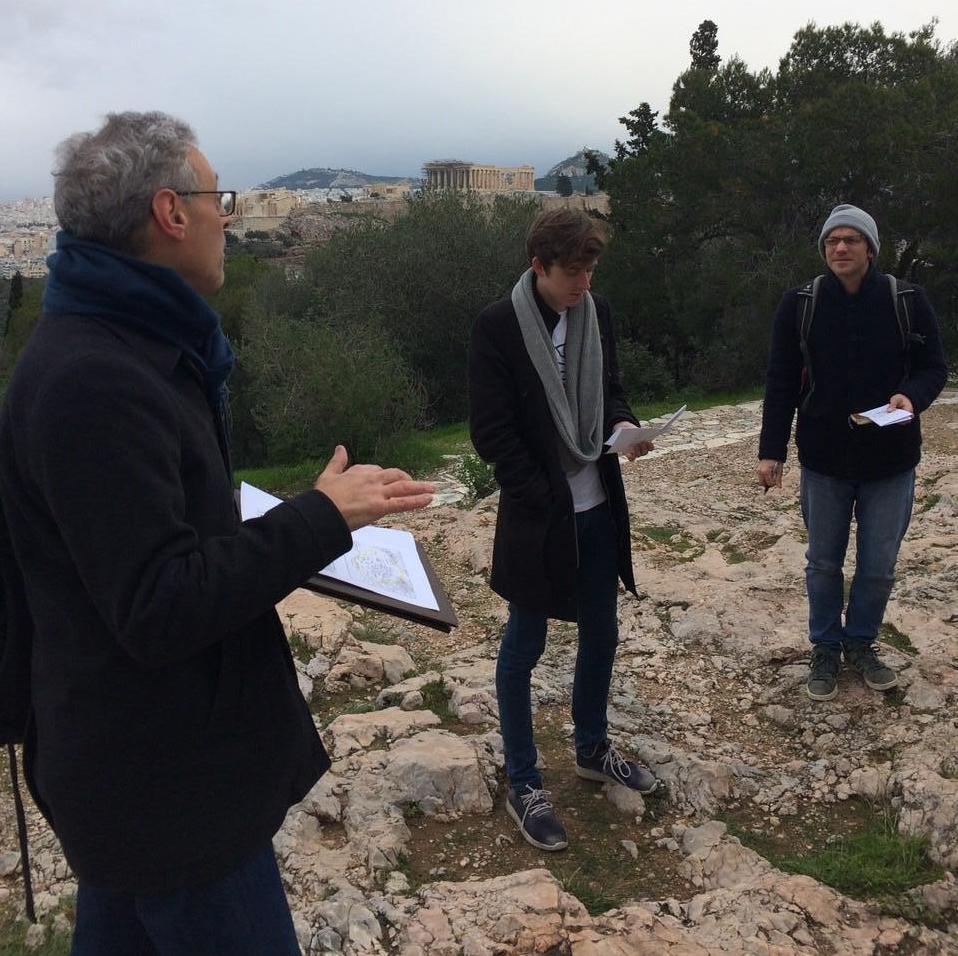ANCH2050 UQ Ancient World Study Tour - January 6-26, 2020
On January 6, just a few short months ago, 25 students of Ancient History, Archaeology, Education, Museum Studies and Art History from UQ met up with UQ Senior Lecturer Dr Amelia R. Brown and recent UQ Classics PhD Dr Annabel Florence in Athens, Greece. It was a dark and stormy winter’s night, and yet the next day dawned clear, cold and sunny for our climb up Philopappos Hill, just behind our hotel and the hostel of the Australian Archaeological Institute at Athens (AAIA). There we enjoyed a panoramic view of the Athenian Acropolis, the blue seas of the Saronic
Mediterranean winter weather to climb up, on and over some 50 archaeological sites, ancient monuments and museums in Athens

and around mainland Greece. The students did the majority of on-site teaching, giving 50 oral presentations from Sparta to Macedon, Actium to Marathon, in ancient agoras and theatres, and from the Stadium of the ancient Olympic games to Armed Aphrodite’s sanctuary atop Acrocorinth. In this blog, Dr Amelia Brown shares some of her highlights from her 6th summer semester UQ Ancient World Study Tour of Greece. Posts by students on the 2020 tour will follow in weeks to come, so get ready to travel back to Greece from the comfort of your homes.
We were very grateful to have the able assistance of AAIA Acting Director Dr Stavros Paspalas in orienting the students to Athens and its ancient monuments over the first few days, from that first view of Athens and the monument of Philopappos himself (G. Julius Antiochus), to the Arsenal of Philo and the harbors of Piraeus. Our warmest thanks are also extended to the whole AAIA staff, especially Executive Officer Dr Lita Tzortzopoulou-Gregory and Finance Officer Brett Myers, not only for our essential guiding and entry permits, but also for all their Australian- and Athenian-based support for this and past UQ summer semester Study Tours of Greece. Special thanks for the AAIA fellowships in 2020 of $1000 each to 3 academically high-achieving students on the tour, and thanks as well to the Queensland Friends of the AAIA for a further $1000 grant to an Education student in financial need. We are also grateful to UQ’s Student Employability Office for supporting the 24 enrolled students with grants of $1000 each to offset the cost to students of hotels, a bus and airfare for the tour.
Some highlights from our first days in Athens included entering the porch of the Parthenon near sunset; exploring the ancient agora from the Temple of Hephaistos and Athena to the Tower of the Winds; and hot chocolate at sunset by the Temple of Poseidon at Sounion after a rousing re-enactment of the Battle of Salamis (State of Origin Round 2). Our tour then continued outside Athens in the footsteps of our Roman imperial travel guide Pausanias to Corinth, Epidaurus and clockwise around the Peloponnesus. At Isthmia’s Sanctuary of Poseidon, we were excited to see the lovely Roman Bath’s black and white mosaic of a marine thiasos uncovered, and we tried out the reconstructed starting line from the Classical stadium.
I passed on some of the excavation history of Isthmia drawn from Dr Tzortzopoulou-Gregory and Professor Timothy Gregory of OSU, as well as Professor Elizabeth Gebhard of the University of Chicago excavations, and even led a few hardy volunteers to walk about 3.5 km from the waterfront of modern Corinth to the western diolkos (dragway) across the Isthmus (and back!).
We climbed Acrocorinth, visiting the newly-refurbished Upper Peirene Fountain and towers there, as well as the Forum, lower Peirene Fountain, the newly-renovated Museum, shops and open tavernas down below in Ancient Corinth. I enjoyed sharing the results of the ongoing excavations at Ancient Corinth by the Archaeological Service and under the auspices of the American School of Classical Studies at Athens; I was fortunate to participate in the latter from 2004 to 2005. I wrote my 2008 PhD at UC Berkeley on the history of the city in Late Antiquity (Corinth in Late Antiquity, IB Tauris 2018, Bloomsbury paperback 2019), and I was glad to share my recent research on Roman portraiture and maritime votives at Corinth and Isthmia with the students. The final highlight of our time in the Corinthia was undoubtedly our tour of the Lechaion Christian Basilica, at Corinth’s ancient western harbor of Lechaion, with Corinth Excavations Emeritus Director Dr Guy Sanders. Students modeled the ancient catechumenate in the ‘sheep dip’ style baptistery; searched for the tombs of 6th- and 7th-century Corinthian clergy; and explored the ruins of the largest church ever built in ancient Greece on the edge of the Corinthian Gulf. Many thanks to Dr Sanders for his tour, and to the students for their enthusiasm, expertise and scholarship on the tour. I’m happy to pass this blog on to them for their contributions on our visit to the Peloponnesus, and then I look forward to returning to tell you more about the tour in the north of Greece.
Dr Amelia Brown is a Senior Lecturer in Greek History and Language, Director RD Milns Antiquities Museum.
https://aaia.sydney.edu.au/university-of-queensland-ancient-world-study-tour-of-greece/
https://aaia.sydney.edu.au/uq-ancient-greece-study-tour-an-artistic-experience-of-antiquity/
https://aaia.sydney.edu.au/uq-ancient-greece-study-tour-the-theatre-of-epidaurus/
https://aaia.sydney.edu.au/uq-ancient-greece-study-tour-messene-to-nikopolis/
